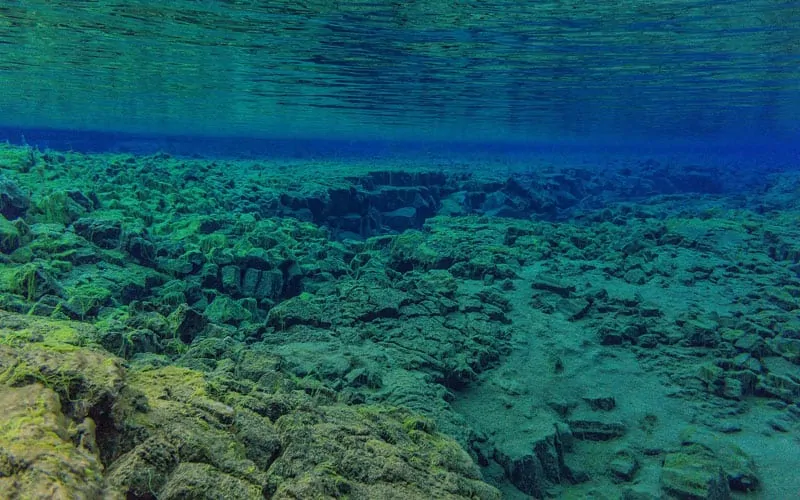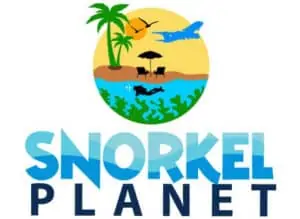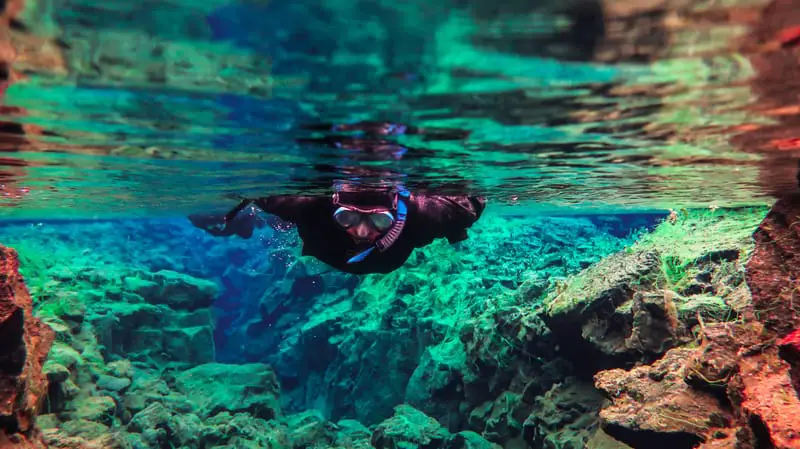
Not your typical snorkeling spot, however, Silfra is definitely one of the most impressive and clearest snorkel sites on planet Earth.
Nowhere else will you find the same crystal clear water, and besides, it’s underwater visibility is beyond compare. A good reason to also mention this spot in our best snorkel locations article.
How to get there
Reykjavik Airport is the nearest airport to Silfra. From there you could either hire a car, grab a taxi or use public transportation.
Location
Silfra is located in the southeast of Iceland in the Thingvellir National Park, next to Thingvallavatn lake. It sits right in the middle of two tectonic plates: The Eurasian plate and the North American plate. After an earthquake in the late 1700’s these two plates moved apart, leaving a “fissure” or a “crack” in the middle. Therefore, Silfra is often referred to as “The Silfra Fissure“.
The diverging tectonic plates opened up a series of underground wells. These wells filled up the fissure, making it an exceptional deep place to snorkel or even scuba dive. In fact, it’s the only place in the world where you can snorkel right between two continental plates.
Silfra is about 60 miles east of Reykjavik, Iceland’s capital and largest city. In Reykjavik you could consider to book a snorkeling day tour with “Dive Center Iceland” (Dive.is). The snorkel tour on their website can be found here. Their pick-up vans will take you to Silfra. However, you can also choose to self-drive and meet at the snorkel location.
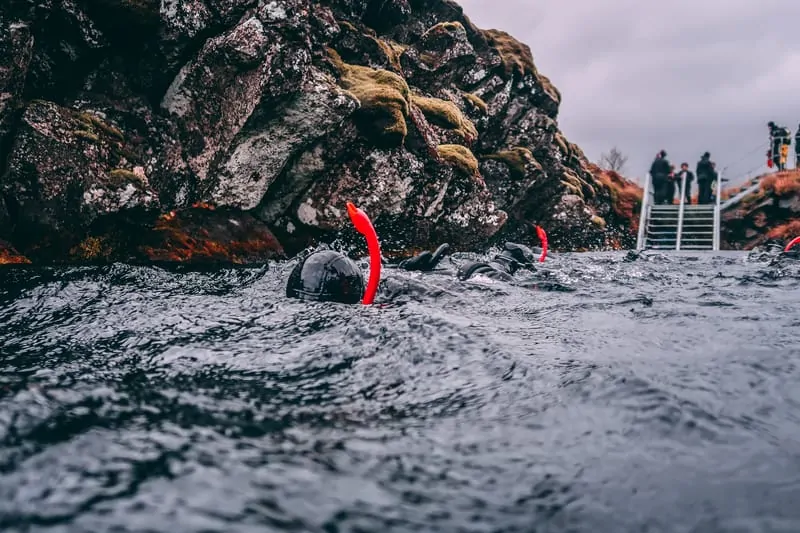
The Water
Now that we know how the fissure was formed, and how wells managed to fill it up, let’s take a closer look at the water.
Close to Silfra there’s a glacier called “Langjökull Glacier”. It’s melting water travels through 50 kilometers of underground lava rocks, heading towards Thingvellir lake. In the northern part of this lake, right in between the tectonic plates, the water is being released through the wells we talked about.
The whole process, from melting glacier water to entering the fissure, takes between 30 to 100 years. Lava is porous and acts as a water filter system. Therefore, after dozens of years, this process results in pure and crystal clear water. You can even drink it if you like.
Another reason for this extremely clear water is it’s low temperature. All year round it stays between 35 to 39°F (2 to 4°C). It never freezes as there’s a continuous addition of fresh water, resulting in a slow but steady current.
What To Expect Underwater
Besides the fact that it’s the only place to snorkel between two continental plates, it’s a must see underwater paradise. Certain locations are as much as 137 feet deep, and give you the impression of floating above a canyon. Especially since your visibility is superb, often all the way to the bottom.
Big and steep rocks will impress every snorkeler. Sometimes they even continue above the ground. The clear water will reflect as blue or turquoise light. In summer, the algae will add a spectacular green color to your sight. Combine this with black and brown bare rock walls, and your perfect snorkel picture is a fact.
So how about fish? Well, unfortunately most fish species aren’t really interested in extreme cold temperatures. However, if you pay close attention, you might see a few. The most common fish to spot is the Arctic Char, especially in august and september (mating season). It’s “little brother”, the Dwarf Char, is present all year round. Unfortunately they prefer the bottom of the fissure, together with a few other little fish. In other words, don’t expect any prominent marine life.
To get a better impression of actual snorkeling footage, here’s a video you might find interesting. It also gives you an impression of the snorkel excursion by Dive.is.
What To Wear
In case you join the snorkeling tour, all necessary equipment will be provided. You need to make sure to bring the following: Thin socks, long underwear and appropriate clothes that match the weather conditions. If you wear glasses you should bring contact lenses in order to fit the snorkel mask. Maybe reading “Can You Snorkel With Glasses” will help you out too.
In order to enter the freezing water, you will need to wear a drysuit for snorkeling. Dive.is provides them. Drysuits use a layer of air to protect you from cold temperatures. They’re not the same as wetsuits. Wetsuits use a layer of water to keep you warm. If you need a drysuit for one reason or another, Amazon offers a whole bunch here. Since they are expensive, you better use the ones that come with the excursion.
The “regular” snorkeling gear you might own yourself could partially be ok to bring with you. However, you should at least wear a 7mm neoprene hood and 7mm neoprene 3-finger gloves. Fins could be a problem too since they need to fit around your drysuit boots. We found this information here.
The Current
Like we already mentioned, there is a continuous slow current running through the fissure. You can let yourself float as you go or change any direction with your fins. Sometimes the rocky walls come pretty close to each other, so having a current will do most of the work already. It also saves your energy if you’re not an experienced snorkeler.
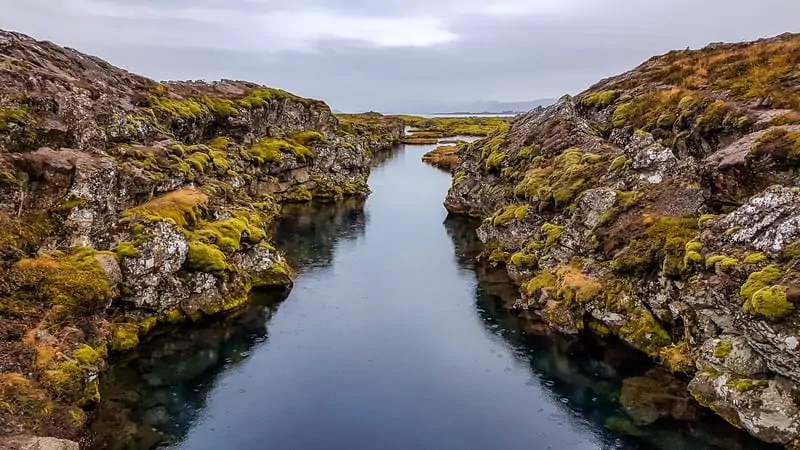
Photography
Whether it’s photography or making videos, this is a place you definitely want to capture on camera. The snorkel tour gives you the option to leave that job to the guides for about 25 bucks.
Above or below the water, this is one amazing place to spend a few hours. So make sure to capture everything you can as it will be the experience of a lifetime.
Even experienced photographers will be amazed by how clear their shots turn out to be. A GoPro could be a fantastic way to keep those memories for a lifetime. If you’re curious, consider reading our “Giant Guide For Snorkeling With A GoPro“.
Tips
It can rain in Silfra. However, there’s nothing to be worried about. As long as it’s not getting too dark outside, your snorkel experience will still be amazing. If you want to learn more, or if you’re generally interested, feel free to read our article about snorkeling in the rain.
The tour requires a minimum age of 12 years, but make sure to inquire about additional rules when bringing a kid. Kids can be great snorkelers, especially when they already practiced. However, not every child is the same. Maybe our Giant Guide For Snorkeling With Kids is worth to check out before going.
Make sure to do a little research on TripAdvisor. There are many discussions about snorkeling in Silfra, and there’s even a list of recommended hotels.
Take care of your belongings. Bringing a GoPro or any other gear can be fun, but once you let go it could be gone forever. Even though there are shallow parts within the excursion, 137 feet fissures are out of reach for snorkelers. If you use a selfie stick, try to get one that floats, just to be safe.
If you’re scared to snorkel, or if you’ve never done it before, maybe this location is a big jump into the unknown. Off course, you could have the time of your life, but “floating” over a valley may be frightening for some of us.
Diving
Both snorkeling and diving are possible in Silfra. If you prefer to go diving, there’s something to keep in mind. Since you’re wearing a drysuit you need to show you’re certified for that. So just having a PADI open water license isn’t enough. Ask the guides up front about their requirements in order to understand if you qualify.
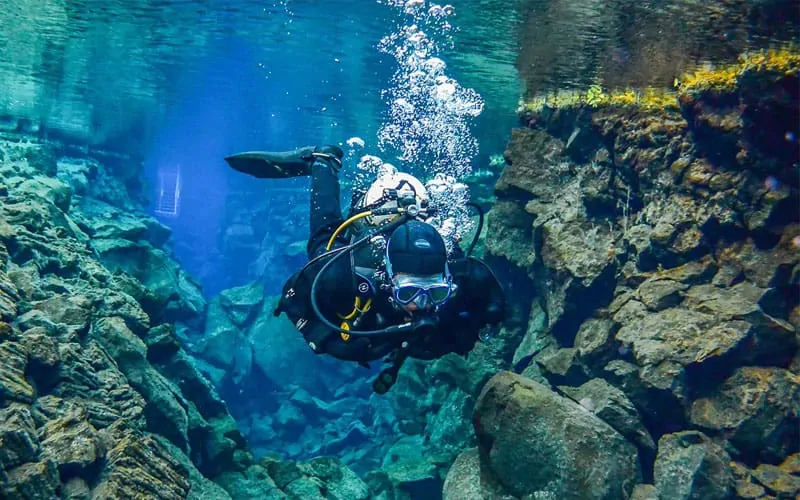
What Else To See In Thingvellir National Park?
This historic site offers great scenery and hiking paths through the so called “Almannagja”. There’s a path you can follow in order to see some fissures from above the ground. You’ll also find the Öxarárfoss waterfall, the old Thingvellir church, booth ruins, the Law Rock, and even more.
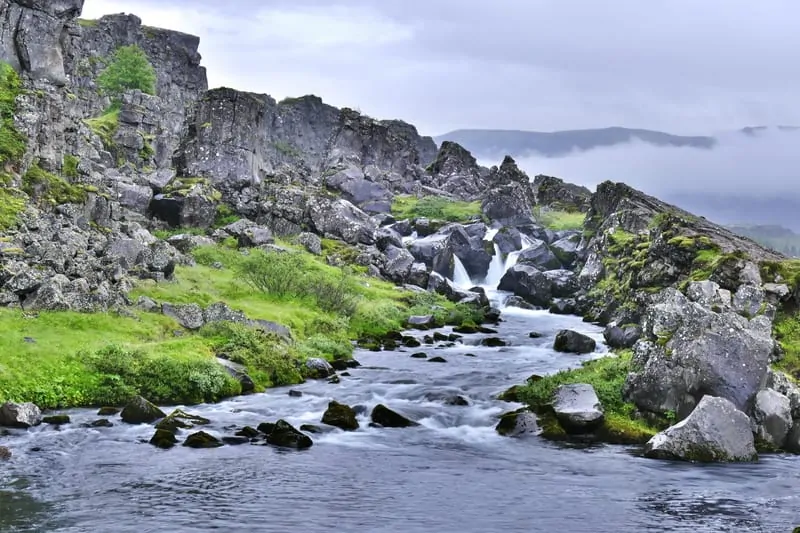
Facts About Silfra
The fissure between the two tectonic plates keeps on growing. Every year they distance themselves by about 2/3 of an inch.
There are 3 snorkel locations in Silfra: Silfra Hall, Silfra Lagoon and Silfra Cathedral. The latter is the most famous one.
The fissure scenery has been nominated as one of the best 5 snorkeling/diving locations in the world.
When snorkeling through the fissures, there are certain places where you’ll be able to touch both of the plates simultaneously. Fun for taking a picture indeed.
Compared to some other “hidden snorkeling secrets”, this location is very easy to get access to.
